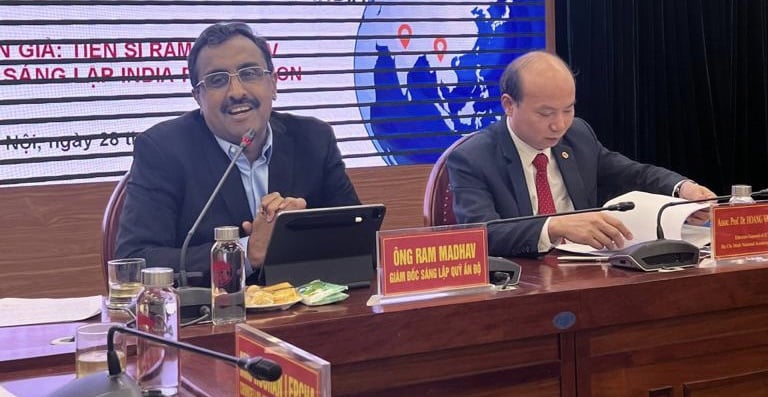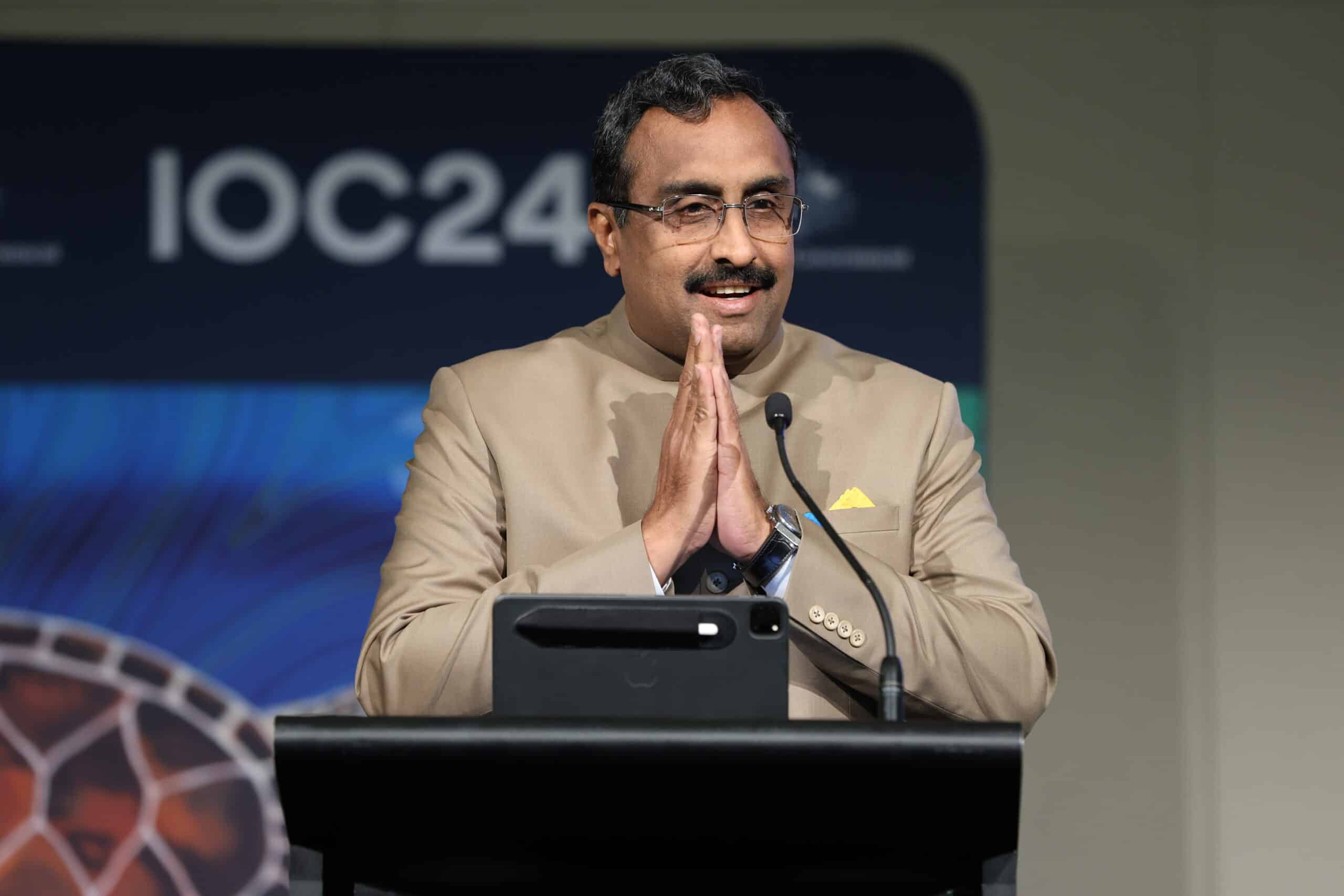
|
Getting your Trinity Audio player ready...
|
Text of Dr Ram Madhav’s address at the Ho Chi Minh National Academy of Politics in Hanoi on the theme of “The Indo-Pacific Region: ASEAN Centrality and the Role of India” delivered on March 28, 2023.
Good Afternoon!
I am delighted to be here in Vietnam, a dear friend of India for millennia. India and Vietnam shared a strong civilisational bond. Remnants of that bond still exist in parts of your country in the form of temples and monasteries. I visited one such Pagoda at Da Lat recently.
We two countries had fought against our colonisers and emerged free after a long struggle. India played the pleasant role of the Chairman of the International Commission for Supervision and Control (ICSC) in 1954 to facilitate the peace process in Vietnam. While people of Vietnam defeated the colonial designs and united the country, India suffered a partition before securing its independence.
India established full diplomatic ties with the country in 1972 that completed fifty years last year. This bilateral relationship is one of the steadiest that India has had and a lot of credit goes to the leadership of Vietnam for that.
* * *
The Prime Ministers of our two countries – Sh Narendra Modi of India and Mr Nguyen Xuan Phuc of Vietnam – met virtually in December 2020 to sign the historic “Joint Vision for Peace, Prosperity and People” that guides our bilateral relationship today.
Prime Minister Narendra Modi’s policy navigation from “Look East” to “Act East” is essentially aimed at strengthening ties with the extended neighbourhood of the Indo-Pacific region. India-Vietnam ties are extremely critical in India’s eastward outreach.
India also envisaged expanded ties between the two countries and elevated bilateral partnership to a “Comprehensive Strategic Partnership” in 2016. Our defence partnership is robust and growing. Along with defence and strategic ties, India has attempted to boost economic relations also with Vietnam. Trade, that forms an important element of our bilateral relationship, has grown more than 75 times in last twenty years – from a mere $200 million in year 2000 to almost $ 15 Billion today – signifying our strong bilateral bonds.
As the ASEAN group of nations emerged on the global horizon as an important economic power bloc, India established ties with the group and also entered into an important Free Trade Agreement with ASEAN in 2010.
On its part, India too registered a spectacular rise in the last two decades, shedding off the image as an underdeveloped and reticent nation. Its economy is performing splendidly well. In just a decade’s time, India’s GDP has grown from $ 1.5 Trillion to $3.15 Trillion catapulting it to the world’s 5th largest economy. It emerged as a leader in digital economy and successfully thwarted pandemic-induced economic instability and downturn to continue to register annual GDP growth rates of above 6%. By conservative projections, India is set to become the world’s 3rd largest economy in two decades time.
* * *
Friends!
The world is at the cusp of a historic transformation. The 19th century was regarded as the European century. European powers like Great Britain, France, Portugal and Spain had held sway over large parts of the world, colonising vast swathes of territory, including over Asian lands and seas. The 20th century witnessed two major wars and a long cold war that resulted in the rise of the American power. In that sense, the 20th century came to be regarded as the American century.
In the final decades of the 20th century, some Asian nations like Japan, South Korea, Singapore and Taiwan started emerging as major economic powers attracting the epithet of “Asian Tigers”. That led to some in the West predicting that the coming century would be the Asian century.
In 1988, when the Indian Prime Minister Rajiv Gandhi visited China, supreme leader of the Chinese Communist Party, Deng Xiaoping told him that he disagreed with the view that “the next century would be the century of Asia and Pacific”. “An Asian century is neither inevitable nor foreordained”, he warned. His warning was on the premise that unless the countries in the region are united, such an ambitious aim cannot be achieved.
In the last few decades, India and China have emerged as two powerful regional powers, gaining “a structural centrality and importance that will make them critical global lynchpins”, as Chris Ogden, Scottish author and professor of international relations put it.
But the 21st century Asia story is not limited to the two big nations. It is the combined rise of traditional and new powers including Vietnam, Japan, South Korea, Indonesia, and Singapore, together with India and China, that has catapulted Asia into the most dynamic region in the 21st Century.
It is a Multipolar Asia today, which is home to three out of five top economies in the world by GDP. It is home to almost 55% of the world’s population. In the next couple of decades, Asia is going to generate 50% of the world GDP, and, going by the purchasing power of its populations, it could account for 40% of global consumption. It’s military spending exceeds that of many other regions.
The global power axis was located in the Pacific-Atlantic region in the last century, when the world was driven largely by the European and American powers. But it has decisively shifted to the Indo-Pacific neighbourhood today.
Story of the rise of Asia in the early decades of this century is fascinating. Kishore Mahbubani ascribed this success to seven pillars, that are: “free-market economics, science and technology, meritocracy, pragmatism, culture of peace, rule of law and education”.
* * *
Ladies and Gentlemen!
Although Asia has emerged as the most happening region today, it is engulfed in myriads of challenges. The South China Sea region in particular and the Indo-Pacific in general has become the flashpoint for great power rivalry. China’s rise as a major power in the last two decades has been anything but peaceful, causing concern to many of its maritime and land neighbours.
The two major powers in the region, India and China, are locked in a longstanding border conflict. A standoff between the armies of the two countries is ongoing in the Himalayan region in India’s North. Several maritime neighbours of China, including Vietnam, are sucked into territorial disputes threatening peace. Tensions in the Taiwan Straits are threatening to lead to another world war of sorts.
Elsewhere, from Afghanistan to Iran to West Asia, a perpetual conflict plagues countries in the region. Unstable regimes, autocracies, military and civilian dictatorships and state and non-state terror infrastructure are pushing the region into a spiral of conflict and calamity.
The result is that although the importance of Asia has risen in global geo-politics, its influence didn’t correspondingly rise.
* * *
Friends!
Today, there is a growing chatter about a new world order. The present world order, built by the Western powers in the post-War era, is facing its stiffest challenge. There is a perceived conflict between the US-centric and Sino-centric worldview, each calling the other calamitous. This conflict is conspicuously evident in Eurasia in the Russia-Ukraine war and also in the South China Sea region of the Indo-Pacific.
This competition between the world powers over the impending world order is shaking the foundations of global peace and harmony. Unsettled questions, unresolved disputes, clashing visions and competing models – we live in the midst of a chaotic world today.
Can the world rise above them?
India believes that the nations in Asia have a greater role in directing the 21st century geo-political realities.
India is committed to a world order that upholds “sovereign inter-state relations and a relatively open global economy, characterised by practices of inclusive, rule-bound multilateralism”. It rejects the authoritarian and coercive world order that some countries seek to impose. As the world’s largest democracy, its commitment to freedom, human rights and peace also is above-board. It contributed significantly to upholding multilateralism through UN and allied institutions.
The West has helped build a just and open world order in the last several decades. But, while defending that order, it also must always remember Samuel Huntington’s warning that “the widespread Western belief in the universality of the West’s values and political systems is naïve, and that continued insistence on such “universal” norms will only further antagonise other civilizations”.
* * *
Ladies and Gentlemen!
In conclusion, let me emphasise that for the Asian century to take shape, we need to prevent great power rivalry from spilling over into our neighbourhood. In his Shangri La Dialogue address in Singapore in 2018, Prime Minister Narendra Modi categorically asserted the ASEAN centrality in the Indo-Pacific affairs. India and ASEAN should together lead Global South in order to shape the 21st century world order that will incorporate noble aspects of the existing order and reject hegemonic aspects being imposed in the name of a new order.
Most importantly, the 21st century world order should have substantive footprints of the Asian civilisational wisdom of which ancient nations like India and Vietnam are the torchbearers.
For that to happen, Asia needs to rise as one force. As Prime Minister Modi pointed out, “Asia of rivalry will hold us all back. Asia of cooperation will shape this century”.
Thank you…



